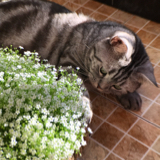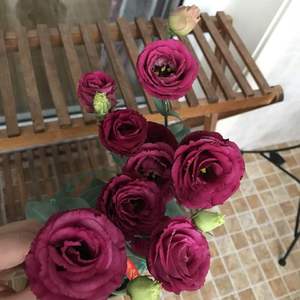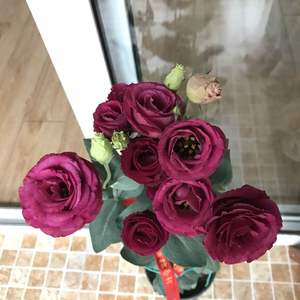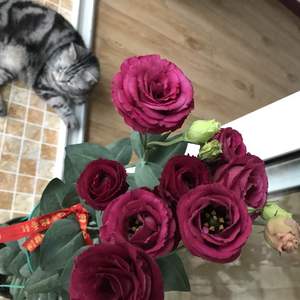文章
Miss Chen
2018年08月09日

Description: This herbaceous plant is a winter or summer annual about 4-18" tall and similarly across; it branches dichotomously. Initially, a few basal leaves develop during the autumn or spring, but during late spring this plant bolts The stems of bolting plants are medium green, terete, and glabrous. Alternate leaves occur along the entire length of these stems, becoming smaller in size as they ascend. They vary in size from ½–3½" long and similarly across. The leaves are medium green, glabrous, and bipinnatifid or tripinnatifid in structure; they branch dichotomously and somewhat irregularly, forming narrowly linear to filiform lobes. These lobes are up to ¾" (20 mm.) long and about 0.5–1 mm. across. The narrow petioles of the leaves are nearly zero to 2" long; they are mostly green and glabrous, although the bases of these petioles have sheaths with white- to brown-membranous margins.
Both axillary and terminal umbels of flowers are produced in abundance. These umbels are usually compound, consisting of 2-3 umbellets (rarely with 4 umbellets), although sometimes they are simple. The compound umbels span about ¾–1¼" (20-32 mm.) across; their peduncles (basal stalks) are ¼–1" (6-24 mm.) long. The rays (basal stalklets) of the umbellets are ascending and divergent; they are ¼–¾" (6-20 mm.) in length. Individual umbellets span ¼–½" (6-12 mm.) across, consisting of 5-15 flowers; their pedicels are nearly zero to ¼" long. The peduncles, rays, and pedicels of each compound umbel are medium green, glabrous, and straight. Both the umbels and umbellets lack floral bracts. Individual flowers are only 1-2 mm. across when they are fully open. Each flower consists of 5 white petals, a toothless green calyx, 5 stamens, and a 2-celled ovary with a pair of short styles. The blooming period occurs during the summer and autumn, lasting about 2-3 months. Only a few flowers are in bloom at the same time.

Afterwards, the flowers are replaced by dry fruits (schizocarps); immature fruits are light green, while mature fruits turn brown; the latter soon fall to the ground. Each schizocarp consists of 2 hairless seeds. Individual seeds are 1.0–1.5 mm. long and asymmetrically ellipsoid in shape; one side of each seed is flat to slightly concave, while the other side is convex and conspicuously ribbed (3 ribs that are separated by 2 furrows). The root system consists of a slender taproot. This plant reproduces by reseeding itself.
Cultivation: The preference is full sun and moist conditions; a variety of soil types are tolerated. This plant will colonize drier ground, but it is vulnerable to hot dry weather. In some situations, this plant can spread aggressively, although this has not been a problem (thus far) in Illinois.

Range & Habitat: The non-native Fir-leaved Celery is a rare weed in Illinois. So far, it has occurred only in Champaign County (see Distribution Map). It is probably native to subtropical areas of Central and South America. However, it has spread to both subtropical and temperate areas throughout the world. Illinois appears to lie along the northern range-limit of this species; it is more common in southeastern and southwestern United States. In Illinois, Fir-leaved Celery was growing in low shrubbery near a parking lot in downtown Champaign, Illinois. It also occurred nearby in weedy turf grass along a roadside. In general, habitats of this plant include cropland, abandoned fields, roadside ditches, areas along railroads, gardens, neglected lawns, and areas around landscape shrubs. Fire and regular mowing are not tolerated. Nonetheless, this plant prefers habitats with a history of disturbance.

Faunal Associations: Floral-faunal relationships for Fir-leaved Celery are not well-understood for North America. Occasionally, White-tailed Deer browse on the foliage (Everitt et al., 1999). Livestock, including dairy cattle, sometimes browse on the foliage of this plant, as there have been some concerns about whether or not it can taint the flavor of milk.
Photographic Location: Low shrubbery and weedy turfgrass in downtown Champaign, Illinois, where this plant has persisted for several years. One of the photographs was taken indoors.

Comments: Sometimes the scientific name of Fir-leaved Celery is spelled Ciclospermum leptophyllum, and another scientific name of this plant is Apium leptophyllum. It also has other common names, including Marsh Parsley and Slender Celery. Fir-leaved Celery is remarkable for its narrowly lobed leaves and abundant umbels of tiny flowers. It is possible to confuse this plant with two other groups of annual plants in the Carrot family, viz. species of Mock Bishop-weed (Ptilimnium spp.) and Scaleseed (Spermolepis spp.), as they also have leaves with very narrow lobes and small white flowers. Species of Mock Bishop-weed differ by having larger compound umbels of flowers with more umbellets and the presence of floral bracts at the bases of their compound umbels. Species of Scaleseed can be distinguished by the bractlets at the bases of their umbellets and the presence of tubercles or bristles on their seeds. In contrast, Fir-leaved Celery lacks both floral bracts and bractlets and its seeds lack tubercles or bristles.
Both axillary and terminal umbels of flowers are produced in abundance. These umbels are usually compound, consisting of 2-3 umbellets (rarely with 4 umbellets), although sometimes they are simple. The compound umbels span about ¾–1¼" (20-32 mm.) across; their peduncles (basal stalks) are ¼–1" (6-24 mm.) long. The rays (basal stalklets) of the umbellets are ascending and divergent; they are ¼–¾" (6-20 mm.) in length. Individual umbellets span ¼–½" (6-12 mm.) across, consisting of 5-15 flowers; their pedicels are nearly zero to ¼" long. The peduncles, rays, and pedicels of each compound umbel are medium green, glabrous, and straight. Both the umbels and umbellets lack floral bracts. Individual flowers are only 1-2 mm. across when they are fully open. Each flower consists of 5 white petals, a toothless green calyx, 5 stamens, and a 2-celled ovary with a pair of short styles. The blooming period occurs during the summer and autumn, lasting about 2-3 months. Only a few flowers are in bloom at the same time.

Afterwards, the flowers are replaced by dry fruits (schizocarps); immature fruits are light green, while mature fruits turn brown; the latter soon fall to the ground. Each schizocarp consists of 2 hairless seeds. Individual seeds are 1.0–1.5 mm. long and asymmetrically ellipsoid in shape; one side of each seed is flat to slightly concave, while the other side is convex and conspicuously ribbed (3 ribs that are separated by 2 furrows). The root system consists of a slender taproot. This plant reproduces by reseeding itself.
Cultivation: The preference is full sun and moist conditions; a variety of soil types are tolerated. This plant will colonize drier ground, but it is vulnerable to hot dry weather. In some situations, this plant can spread aggressively, although this has not been a problem (thus far) in Illinois.

Range & Habitat: The non-native Fir-leaved Celery is a rare weed in Illinois. So far, it has occurred only in Champaign County (see Distribution Map). It is probably native to subtropical areas of Central and South America. However, it has spread to both subtropical and temperate areas throughout the world. Illinois appears to lie along the northern range-limit of this species; it is more common in southeastern and southwestern United States. In Illinois, Fir-leaved Celery was growing in low shrubbery near a parking lot in downtown Champaign, Illinois. It also occurred nearby in weedy turf grass along a roadside. In general, habitats of this plant include cropland, abandoned fields, roadside ditches, areas along railroads, gardens, neglected lawns, and areas around landscape shrubs. Fire and regular mowing are not tolerated. Nonetheless, this plant prefers habitats with a history of disturbance.

Faunal Associations: Floral-faunal relationships for Fir-leaved Celery are not well-understood for North America. Occasionally, White-tailed Deer browse on the foliage (Everitt et al., 1999). Livestock, including dairy cattle, sometimes browse on the foliage of this plant, as there have been some concerns about whether or not it can taint the flavor of milk.
Photographic Location: Low shrubbery and weedy turfgrass in downtown Champaign, Illinois, where this plant has persisted for several years. One of the photographs was taken indoors.

Comments: Sometimes the scientific name of Fir-leaved Celery is spelled Ciclospermum leptophyllum, and another scientific name of this plant is Apium leptophyllum. It also has other common names, including Marsh Parsley and Slender Celery. Fir-leaved Celery is remarkable for its narrowly lobed leaves and abundant umbels of tiny flowers. It is possible to confuse this plant with two other groups of annual plants in the Carrot family, viz. species of Mock Bishop-weed (Ptilimnium spp.) and Scaleseed (Spermolepis spp.), as they also have leaves with very narrow lobes and small white flowers. Species of Mock Bishop-weed differ by having larger compound umbels of flowers with more umbellets and the presence of floral bracts at the bases of their compound umbels. Species of Scaleseed can be distinguished by the bractlets at the bases of their umbellets and the presence of tubercles or bristles on their seeds. In contrast, Fir-leaved Celery lacks both floral bracts and bractlets and its seeds lack tubercles or bristles.
0
0
绝骨
2018年08月02日

18年8月2日,帝都,爆热。迎来了4位新成员:半球,果冻,冰玉,达摩。总之折腾了1个多小时,种上了。说实在的,这两天买还不如一个月前暴雨时候买,至少那会儿凉快啊!但是手欠啊!就买了哈哈哈。放在没直晒又通风的北窗台,晾着。听天由命。


1
0
文章
Miss Chen
2018年08月01日

Description: This plant is a summer annual that becomes 3-18" tall; it is low and spreading, but not prostrate. The stems are pinkish red, round, and hairless, except for a few fine hairs on new growth. The opposite leaves are up to 2" long and ¾" across. They are oblong, with short petioles and margins that are smooth or irregularly serrate. The lower surface of each leaf is light green, while the upper surface may have a red blotch in the middle. A few fine hairs may occur near the base of eachStems, Leaves, & Flowers leaf. The inflorescence consists of a small cyathium on a straight pedicel. Usually, several cyathia develop near the ends of each major stem when a plant is mature. A cyathium is a small cup-like structure containing the pistillate flower and one or more staminate flowers, which have neither true petals nor sepals. It is initially green, but often turns red in bright sunlight. On this particular species, the cyathium has 4 tiny petal-like appendages that are bright white. Eventually, a round tripartite fruit develops from the cyathium on a short stalk; it often turns red in bright sunlight as well. This fruit is noticeably larger than the flowers. The blooming period is mid-summer to fall, lasting about 1-2 months. There is no noticeable floral scent. The root system consists of a slender central taproot.
Cultivation: The preference is full sunlight, dry conditions, and poor soil. The soil can contain significant amounts of gravel, sand, or clay. Foliar disease rarely bothers the leaves, and drought resistance is excellent. This plant can reseed itself readily in sunny open areas.
Range & Habitat: The native Nodding Spurge is a common plant that occurs in nearly every county of Illinois (see Distribution Map). Habitats include dry upland areas of prairies, clay prairies, gravel prairies, thickets, openings in upland woodlands, fields and pastures (whether abandoned or still in use), areas along roadsides and railroads, poorly maintained lawns and gardens, and miscellaneous waste areas. This plant prefers disturbed open areas and it is somewhat weedy. This plant seems to be more common in rural than urban areas, possibly because of its intolerance to herbicides and frequent mowing of lawns.
Faunal Associations: The tiny flowers occasionally attract small bees, Syrphid flies, and wasps. These insects seek nectar primarily. The seeds are consumed by the Mourning Dove and Greater Prairie Chicken, and to a lesser extent by the Bobwhite and Horned Lark. The Wild Turkey has been known to eat the foliage, developing buds, and fruits, apparently without ill effects. Mammalian herbivores rarely eat this plant because of the poisonous white latex in the stems and foliage.
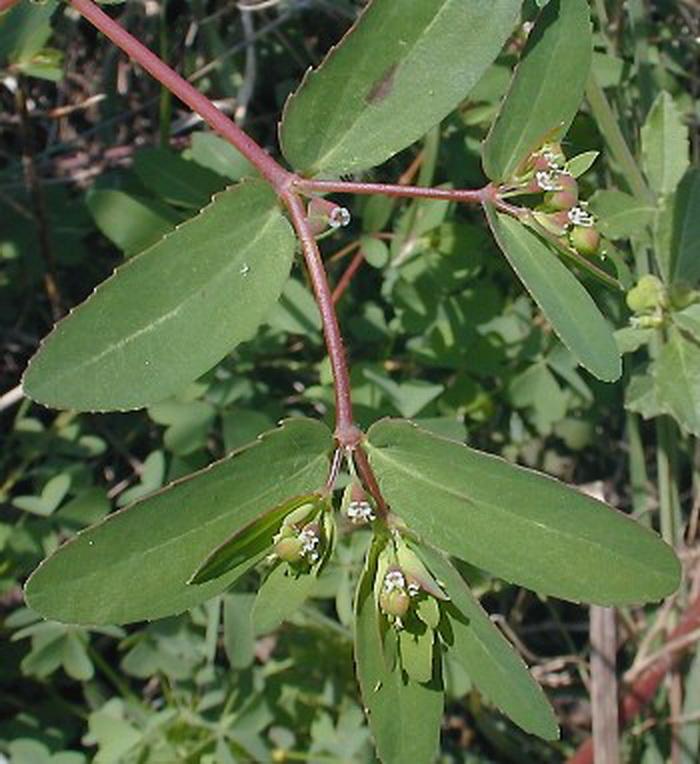
Photographic Location: The photographs were taken at the Windsor Road Prairie in Champaign, Illinois. Some flowers are in bloom in one of the photographs as their stamens are clearly visible.
Comments: The Nodding Spurge can be readily distinguished from other Chamaesyce spp. by its more erect habit, larger leaves, and mostly hairless stems. Several scientific names have been applied to the Nodding Spurge in the past, including Chamaesyce maculata, Euphorbia maculata, and Euphorbia preslii. Sometimes the entire plant will turn reddish green in response to strong sunlight and dry conditions.
Cultivation: The preference is full sunlight, dry conditions, and poor soil. The soil can contain significant amounts of gravel, sand, or clay. Foliar disease rarely bothers the leaves, and drought resistance is excellent. This plant can reseed itself readily in sunny open areas.
Range & Habitat: The native Nodding Spurge is a common plant that occurs in nearly every county of Illinois (see Distribution Map). Habitats include dry upland areas of prairies, clay prairies, gravel prairies, thickets, openings in upland woodlands, fields and pastures (whether abandoned or still in use), areas along roadsides and railroads, poorly maintained lawns and gardens, and miscellaneous waste areas. This plant prefers disturbed open areas and it is somewhat weedy. This plant seems to be more common in rural than urban areas, possibly because of its intolerance to herbicides and frequent mowing of lawns.
Faunal Associations: The tiny flowers occasionally attract small bees, Syrphid flies, and wasps. These insects seek nectar primarily. The seeds are consumed by the Mourning Dove and Greater Prairie Chicken, and to a lesser extent by the Bobwhite and Horned Lark. The Wild Turkey has been known to eat the foliage, developing buds, and fruits, apparently without ill effects. Mammalian herbivores rarely eat this plant because of the poisonous white latex in the stems and foliage.

Photographic Location: The photographs were taken at the Windsor Road Prairie in Champaign, Illinois. Some flowers are in bloom in one of the photographs as their stamens are clearly visible.
Comments: The Nodding Spurge can be readily distinguished from other Chamaesyce spp. by its more erect habit, larger leaves, and mostly hairless stems. Several scientific names have been applied to the Nodding Spurge in the past, including Chamaesyce maculata, Euphorbia maculata, and Euphorbia preslii. Sometimes the entire plant will turn reddish green in response to strong sunlight and dry conditions.
0
0
文章
Miss Chen
2018年07月10日

Description: This herbaceous plant is a winter or spring annual, producing leafy and flowering stems about 4-18" (10-45 cm.) long. These stems branch primarily near the base of the plant and they are ascending to widely sprawling. Individual stems are whitish green to light reddish green, terete, and woolly-pubescent. Alternate leaves occur along these stems that are ¾-2" (2-5 cm.) long and about one-half as much across; they are broadly oblong in outline, while their structure is deeply bipinnatifid. The ultimate leaf segments are 1.5-5.0 mm. long and about one-third as much across; these segments are oblong-acute in shape. The leaves are pale green and they are covered with short woolly pubescence that becomes more sparse with age. The short petioles are relatively broad, flattened, and whitish green to nearly white; they usually have simple or pinnate lobes along their margins that resemble the leaf segments.
The upper stems terminate in individual flowerheads that span about ¾-1¼" (2-3 cm.) across; these flowerheads have peduncles that are 1½-6" (4-15 cm.) in length. These peduncles are pale green, terete, and woolly-pubescent. Usually, small alternate bracts occur along the peduncles that resemble the leaves. Each daisy-like flowerhead has 10-18 ray florets that surround numerous disk florets; the ray florets are fertile and pistillate, while the disk florets are fertile and perfect. The petaloid rays of the ray florets are white, oblong in shape, and notched at their tips. The tiny corollas of the disk florets are yellow, tubular in shape, and 5-lobed at their apices; these lobes are triangular in shape. Alongside the disk florets, there are chaffy scales about 4 mm. in length. These scales are oblanceolate in shape and their tips are acute; sometimes these tips are awn-like. At the base of each flowerhead, there are 1-2 series of phyllaries (floral bracts) that are broadly oblong in shape. Individual phyllaries have convex central ridges that are light green, wide membranous margins that are white to light brown, and woolly pubescence; the phyllaries become chaffy with age. The foliage of this plant lacks a significant fragrance, although the crushed flowerheads are mildly fragrant (resembling apple-pineapple). The flowerheads are solid, lacking hollow centers. The blooming period usually occurs from late spring to mid-summer, lasting about 1-2 months, although some plants may bloom later in the year.

At maturity, the seedheads are ovoid in shape. The achenes are 1.5-2.5 mm. in length, oblanceoloid in shape, and slightly 4-angled; they are truncate at their apices, where they lack tufts of hair or significant scales. The sides of mature achenes have longitudinal ribs that are readily visible. The achenes are distributed to a limited extent by wind and probably by water at some locations. The root system consists of a shallow much-branched taproot or it is fibrous. Reproduction is by seeds.
Cultivation: The preference is full sun, moist to dry-mesic conditions, and a calcareous soil containing clay-loam, loam, silt, gravel, or sand. Drought tolerance is good. The seeds can remain viable in the ground for 10 years or more (Kay, 1971).
Range & Habitat: Field Chamomile has been found in scattered locations across Illinois (see Distribution Map), but this non-native plant is relatively uncommon within the state. It was introduced into North America from Eurasia, where it is native. In Illinois, habitats consist of fallow fields, roadsides, flood zones along drainage canals and retention ponds, vacant lots and abandoned homestead sites, and waste areas. Highly disturbed areas are preferred.

Faunal Associations: The flowerheads probably attract small bees, various flies (including Syrphid flies), and other insects. Both nectar and pollen are available as floral rewards to such visitors. Insects that feed destructively on Field Chamomile and other Anthemis spp. include Polymerus basalis (Red-Spotted Aster Mirid) and two aphids, Macrosiphoniella tanacetaria and Macrosiphoniella tapuskae. The former aphid is typically found on the flowerheads, peduncles, and upper stems, while the latter aphid is typically found on the lower leaves. The polyphagous caterpillars of a moth, Orthonama obstipata (The Gem), have been reported to feed on mayweeds by Covell (1984/2005). Field Chamomile belongs to the group of plants that are commonly referred to as mayweeds in Europe. The foliage of Field Chamomile is probably browsed sparingly by mammalian herbivores, while Canada Geese seem to avoid it. Because the seeds can pass through the gastrointestinal tracts of both cattle and pigeons and remain viable (Kay, 1971), these animals may spread them to new areas. It is also possible for the seeds to cling to the bottoms of the muddy shoes of people and the muddy hoofs of animals, by which means they can spread to new areas.
Photographic Location: Along a drainage canal and retention pond area in Champaign, Illinois.

Comments: Field Chamomile (Anthemis arvensis) is one of the plants that are commonly referred to as mayweeds. Examples of these species include Anthemis cotula (Dog Fennel), Chamaemelum nobile (Roman Chamomile), Matricaria recutita (German Chamomile), and Tripleurospermum perforatum (Scentless Chamomile). As a group, they are difficult to distinguish from each other. All of these species have daisy-like flowerheads that resemble those of Leucanthemum vulgare (Ox-Eye Daisy), but their foliage is deeply dissected (typically bipinnatifid). Field Chamomile can be distinguished from other mayweeds by its flat leaf-segments (rather than terete leaf-segments), by the presence and shape of the chaffy scales in its flowerheads, by the woolly pubescence of its foliage, and by the appearance of its achenes. The foliage of Field Chamomile lacks the pleasant fragrance of Roman Chamomile, nor does it possess the unpleasant odor of Dog Fennel. Similar to German Chamomile, the crushed flowerheads of Field Chamomile are mildly fragrant, but it has completely solid flowerheads, whereas the flowerheads of German Chamomile have interiors that are partly hollow.
The upper stems terminate in individual flowerheads that span about ¾-1¼" (2-3 cm.) across; these flowerheads have peduncles that are 1½-6" (4-15 cm.) in length. These peduncles are pale green, terete, and woolly-pubescent. Usually, small alternate bracts occur along the peduncles that resemble the leaves. Each daisy-like flowerhead has 10-18 ray florets that surround numerous disk florets; the ray florets are fertile and pistillate, while the disk florets are fertile and perfect. The petaloid rays of the ray florets are white, oblong in shape, and notched at their tips. The tiny corollas of the disk florets are yellow, tubular in shape, and 5-lobed at their apices; these lobes are triangular in shape. Alongside the disk florets, there are chaffy scales about 4 mm. in length. These scales are oblanceolate in shape and their tips are acute; sometimes these tips are awn-like. At the base of each flowerhead, there are 1-2 series of phyllaries (floral bracts) that are broadly oblong in shape. Individual phyllaries have convex central ridges that are light green, wide membranous margins that are white to light brown, and woolly pubescence; the phyllaries become chaffy with age. The foliage of this plant lacks a significant fragrance, although the crushed flowerheads are mildly fragrant (resembling apple-pineapple). The flowerheads are solid, lacking hollow centers. The blooming period usually occurs from late spring to mid-summer, lasting about 1-2 months, although some plants may bloom later in the year.

At maturity, the seedheads are ovoid in shape. The achenes are 1.5-2.5 mm. in length, oblanceoloid in shape, and slightly 4-angled; they are truncate at their apices, where they lack tufts of hair or significant scales. The sides of mature achenes have longitudinal ribs that are readily visible. The achenes are distributed to a limited extent by wind and probably by water at some locations. The root system consists of a shallow much-branched taproot or it is fibrous. Reproduction is by seeds.
Cultivation: The preference is full sun, moist to dry-mesic conditions, and a calcareous soil containing clay-loam, loam, silt, gravel, or sand. Drought tolerance is good. The seeds can remain viable in the ground for 10 years or more (Kay, 1971).
Range & Habitat: Field Chamomile has been found in scattered locations across Illinois (see Distribution Map), but this non-native plant is relatively uncommon within the state. It was introduced into North America from Eurasia, where it is native. In Illinois, habitats consist of fallow fields, roadsides, flood zones along drainage canals and retention ponds, vacant lots and abandoned homestead sites, and waste areas. Highly disturbed areas are preferred.

Faunal Associations: The flowerheads probably attract small bees, various flies (including Syrphid flies), and other insects. Both nectar and pollen are available as floral rewards to such visitors. Insects that feed destructively on Field Chamomile and other Anthemis spp. include Polymerus basalis (Red-Spotted Aster Mirid) and two aphids, Macrosiphoniella tanacetaria and Macrosiphoniella tapuskae. The former aphid is typically found on the flowerheads, peduncles, and upper stems, while the latter aphid is typically found on the lower leaves. The polyphagous caterpillars of a moth, Orthonama obstipata (The Gem), have been reported to feed on mayweeds by Covell (1984/2005). Field Chamomile belongs to the group of plants that are commonly referred to as mayweeds in Europe. The foliage of Field Chamomile is probably browsed sparingly by mammalian herbivores, while Canada Geese seem to avoid it. Because the seeds can pass through the gastrointestinal tracts of both cattle and pigeons and remain viable (Kay, 1971), these animals may spread them to new areas. It is also possible for the seeds to cling to the bottoms of the muddy shoes of people and the muddy hoofs of animals, by which means they can spread to new areas.
Photographic Location: Along a drainage canal and retention pond area in Champaign, Illinois.

Comments: Field Chamomile (Anthemis arvensis) is one of the plants that are commonly referred to as mayweeds. Examples of these species include Anthemis cotula (Dog Fennel), Chamaemelum nobile (Roman Chamomile), Matricaria recutita (German Chamomile), and Tripleurospermum perforatum (Scentless Chamomile). As a group, they are difficult to distinguish from each other. All of these species have daisy-like flowerheads that resemble those of Leucanthemum vulgare (Ox-Eye Daisy), but their foliage is deeply dissected (typically bipinnatifid). Field Chamomile can be distinguished from other mayweeds by its flat leaf-segments (rather than terete leaf-segments), by the presence and shape of the chaffy scales in its flowerheads, by the woolly pubescence of its foliage, and by the appearance of its achenes. The foliage of Field Chamomile lacks the pleasant fragrance of Roman Chamomile, nor does it possess the unpleasant odor of Dog Fennel. Similar to German Chamomile, the crushed flowerheads of Field Chamomile are mildly fragrant, but it has completely solid flowerheads, whereas the flowerheads of German Chamomile have interiors that are partly hollow.
0
0
文章
Miss Chen
2018年06月27日

Description: This wildflower is either a short-lived perennial or summer annual. It is usually a short bushy plant about 4–18" tall, although larger specimens have been reported. The much-branched stems are light to medium green, glabrous, sometimes glaucous, 4-angled or terete, and sometimes narrowly winged. The opposite leaves are about ½–1½" long, ¼–¾" across, and sessile; they are medium green, broadly oblong to oval in shape with 1-5 prominent veins, smooth among their margins, and glabrous. The upper stems terminate in small clusters (cymes) of flowers. Individual flowers are ¼" across, consisting of 5 yellow to yellow-orangeFlowering Plant petals, 5 green sepals, a light green pistil with 3 styles, and 5-15 stamens. The petals and sepals are about the same length; the petals are oblong, while the sepals are linear-oblong. The peduncle and pedicels of the flowers are light to medium green, slender, and glabrous; sometimes there are small scale-like bracts near the area where two pedicels diverge. These bracts are linear-lanceolate in shape and much smaller in size than the leaves. The blooming period occurs from mid-summer to early fall and lasts about 2-3 months. Usually, only a few flowers are in bloom at the same time. Each flower is replaced by an ovoid seed capsule that becomes up to 1/3" (8 mm.) tall at maturity; this glabrous capsule has remnants of the styles at its apex and it is 3-celled. Each cell of the capsule contains numerous tiny seeds that are dark-colored, narrowly oblongoid, and somewhat flattened. The persistent sepals become enlarged as the seed capsules mature; the sepals are usually about the same length or a little longer than full-sized capsules. This wildflower reproduces by reseeding itself.
Cultivation: The preference is full sun to light shade, wet to moist conditions, and acidic soil that is either sandy or rocky.
Range & Habitat: The native Dwarf St. John's Wort is occasional in most areas of Illinois, otherwise it is uncommon or absent (see Distribution Map). Habitats include sandy forests in floodplain areas, sandy swamps, wet to moist sand prairies, gravelly seeps and springs with an acidic bedrock (e.g., sandstone), damp depressions in sandstone glades, damp depressions along sandstone cliffs, low sandy areas along rivers and ponds, damp depressions in sandy paths, and abandoned sandy fields. This wildflower is found in both disturbed and little-disturbed habitats.
Faunal Associations: The flowers are cross-pollinated primarily by small bees, which collect pollen. Some flies may visit the flowers to feed on the pollen. Nectar is not available as a floral reward. There are a small number of insects that feed on various parts of Hypericum spp. (St. John's Wort species). These insect feeders include the caterpillars of several moths, some leaf beetles, the aphid Brachysiphum hyperici, and the caterpillars of the butterfly Strymon melinus (Gray Hairstreak). See the Insect Table for a listing of these insect species. Mammalian herbivores usually avoid consumption of the foliage because of its toxicity. The foliage contains hypericin, which produces a photosensitive reaction to sunlight, particularly in light-skinned animals.

Photographic Location: A damp depression in a sandy path at the Iroquois County Conservation Area in Illinois.
Comments: This wildflower resembles a dwarf version of the better-known Hypericum spp. (St. John's Wort species). Other small-flowered Hypericum spp. (flowers 1/3" across or less) usually have more narrow leaves and therefore are easily distinguished from Dwarf St. John's Wort. An exception is Hypericum boreale (Northern St. John's Wort), which is rare in Illinois. Generally, Northern St. John's Wort can be distinguished from Dwarf St. John's Wort and other small-flowered species in this genus by its leafy floral bracts, which resemble small leaves. It also has purple seed capsules that are as long or longer than its sepals. Dwarf St. John's Wort, in contrast, has tiny scale-like floral bracts and its seed capsules usually remain green for a longer period of time.
Cultivation: The preference is full sun to light shade, wet to moist conditions, and acidic soil that is either sandy or rocky.
Range & Habitat: The native Dwarf St. John's Wort is occasional in most areas of Illinois, otherwise it is uncommon or absent (see Distribution Map). Habitats include sandy forests in floodplain areas, sandy swamps, wet to moist sand prairies, gravelly seeps and springs with an acidic bedrock (e.g., sandstone), damp depressions in sandstone glades, damp depressions along sandstone cliffs, low sandy areas along rivers and ponds, damp depressions in sandy paths, and abandoned sandy fields. This wildflower is found in both disturbed and little-disturbed habitats.
Faunal Associations: The flowers are cross-pollinated primarily by small bees, which collect pollen. Some flies may visit the flowers to feed on the pollen. Nectar is not available as a floral reward. There are a small number of insects that feed on various parts of Hypericum spp. (St. John's Wort species). These insect feeders include the caterpillars of several moths, some leaf beetles, the aphid Brachysiphum hyperici, and the caterpillars of the butterfly Strymon melinus (Gray Hairstreak). See the Insect Table for a listing of these insect species. Mammalian herbivores usually avoid consumption of the foliage because of its toxicity. The foliage contains hypericin, which produces a photosensitive reaction to sunlight, particularly in light-skinned animals.

Photographic Location: A damp depression in a sandy path at the Iroquois County Conservation Area in Illinois.
Comments: This wildflower resembles a dwarf version of the better-known Hypericum spp. (St. John's Wort species). Other small-flowered Hypericum spp. (flowers 1/3" across or less) usually have more narrow leaves and therefore are easily distinguished from Dwarf St. John's Wort. An exception is Hypericum boreale (Northern St. John's Wort), which is rare in Illinois. Generally, Northern St. John's Wort can be distinguished from Dwarf St. John's Wort and other small-flowered species in this genus by its leafy floral bracts, which resemble small leaves. It also has purple seed capsules that are as long or longer than its sepals. Dwarf St. John's Wort, in contrast, has tiny scale-like floral bracts and its seed capsules usually remain green for a longer period of time.
0
0
成长记
choya8684
2018年06月18日

6/18加入黃金萬年草


1
0
choya8684:@Summers 其實不會耶,因為大顆的都是徒長狀態,組盆之後下層葉子幾乎都掉光所以才塞了萬年草進去
Summers:好像有點揹擠~
求助
胡小林
2018年06月13日

5月18日到6月14日的变化。是否在徒长?该怎么调整?请行家指点!
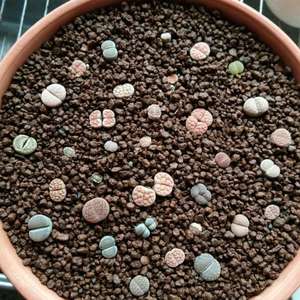
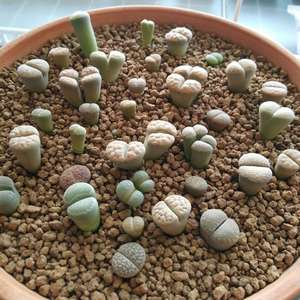


0
0
胡小林:@Fion:光照时长不足,加补光灯吧。谢谢你的指点!
Fion:徒了,减少浇水,拉长浇水间隔,保持每天至少3小时日照。只能不让继续徒,没办法变回原来的样子的啊,这是个人经验,你可以尝试看看
文章
权问薇
2018年05月20日


一、养殖环境
1、土壤:要使用排水性良好的沙质土壤,尽可能不要使用黏重、透气性不好的土壤。
2、温度:夏季温度控制在18-22℃最佳,冬季朱顶红处于休眠的状态,温度不要低于5℃。
3、光照:朱顶红喜欢在阳光充足的环境生长,不能长时间接受阳光直晒,最好是将它放在通风好、明亮且没有强光直射的窗口。
4、浇水:浇水的时候要透彻,浇水量不要过多,以免出现积水影响其生长。

二、繁殖方法
1、播种繁殖:种子成熟之后就可以播种,一般在18-20℃发芽比较快,幼苗在移栽的时候要小心,不要伤害到根部,播种留经二次移植后就可以装进小盆了。
2、扦插繁殖:将它的母球纵切成很多份,然后再分切它的鳞片,将其斜着插在基质中,等到长出真叶时进行定植。

三、常见病害
1、斑点病:会危害到叶子、花朵及鳞茎,病变位置会出现圆形的斑点,在发病后及时将病叶摘除,同时配合喷洒多菌灵杀菌。
2、病毒病:发病后会导致叶子变黄甚至腐烂,甚至是整株死亡,发病时及时将病变的叶子、鳞茎腐烂部位剪掉,用温水浸泡3小时左右就可以轻松防治。

0
0




